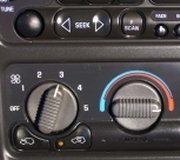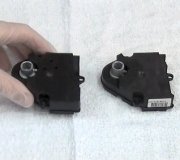An automotive heater is used to supply warmth to the passengers of the vehicle. Conventionally this has been done using the coolant heated from the engine and then run through the heater core via the heater hoses. For electric motor vehicles this is achieved by heating a set of resistance wires (much like a bread toaster) using the main battery and then allowing a blower fan to push the heated air through the vents. Heater system controls are adjusted by one of two ways, either a manual system is used which is adjusted by the driver or a climate control computer responds to a setting which is then automatically adjusted. Some manufactures have separated the heater system into passenger and drivers side controls which offer independent temperature adjustments. Many aspects of the heater system can malfunction such as an engine coolant leak can develop which hinders the performance of the heater system, these leaks must be repaired before proper heater operation will return.
How a heater works
Once the engine has been started and has run long enough to warm up the hot coolant
is transferred into the heater core which is located inside the passenger compartment
via the heater hoses. Most heater core inlet and outlet hoses can be identified
by the diameter sizes of 1/2", 5/8" and 3/4".

The heater core and air conditioner evaporator are housed in the same unit called
a heater box or plenum. This unit is where several
air blend doors and ducts are located
which divert air to various vents, floor, midway and upper (defrost).

In this illustration the heater box has been removed to show the air flow blend
door which swings from one opening to the next mixing or stopping the air flow from
one vent system to another.

Air control doors are actuated by cable, vacuum or electrical servo motors which
can be maneuvered using a manual lever or automatically from the HVAC system controls.

Blend door actuator motors are
used to move a specific door which controls air vent outputs such as defrost, mid
and floor vents.

The heater core itself looks much like a small radiator and acts much in the
same way by running hot engine coolant into the core and forcing air through it
which delivers the heated air. When a heater core fails a coolant residue may be
observed upon the passenger side floorboard this will typically be accompanied by
a sweet, pungent odor which can come from the vents. Some vehicles utilize a heater
control valve which is used to stop the coolant from flowing into the heater core
when the heater system is not being used. If an audible bubbling noise is heard
from the heater core area (like a fish tank) it's is due to air being trapped inside
the heater core, in time the air should dissipate to silence the noise.

A blower fan motor is used to push air throughout the ventilation system which
is controlled by the driver via the temperature control knob or climate control
computer.

A fuse is used to protect the
heater system which is located in the power distribution center and can be checked
by using a test light.

Warm air is pushed through the upper vents which are located at the front of
the dashboard near the windshield. These vents are used to remove moisture from
the inside of the windshield which helps improve visibility.

The mid level vents are primarily used for direct passenger comfort and have
the ability to control and direct the airflow.

Heater floor vents are located below the dashboard and are used to provide warm
air to the lower portion of the passenger compartment.

Questions?
Our certified technicians are ready to answer heater questions for free. We hope you saved money and learned from this guide. We are creating a full set of car repair guides. Please subscribe to our 2CarPros YouTube channel and check back often for new videos which are uploaded regularly.



